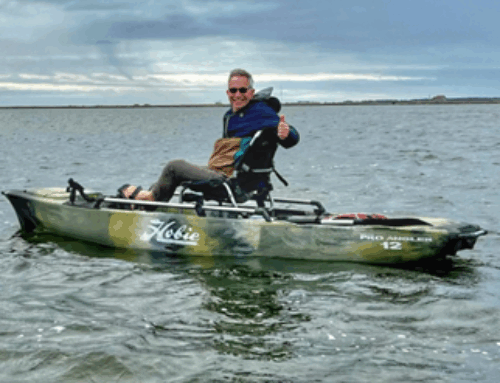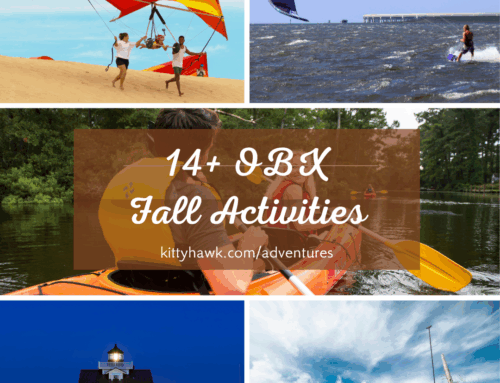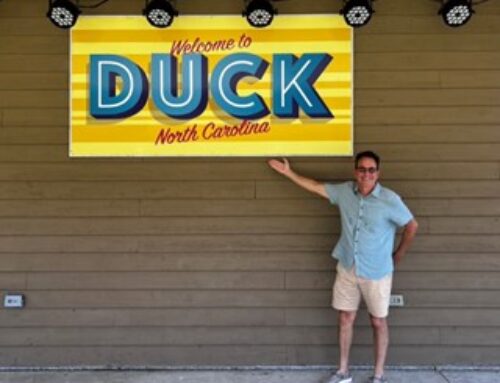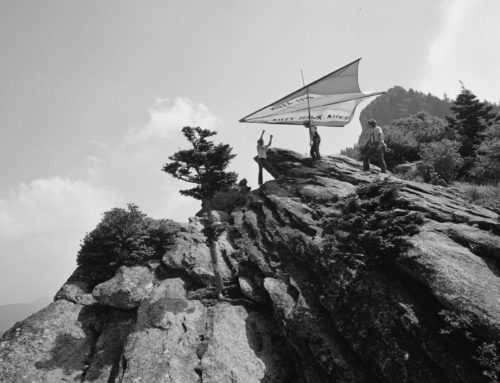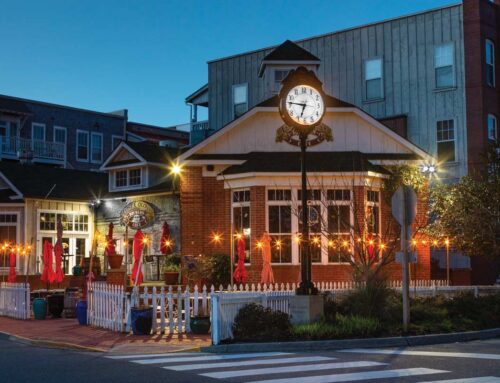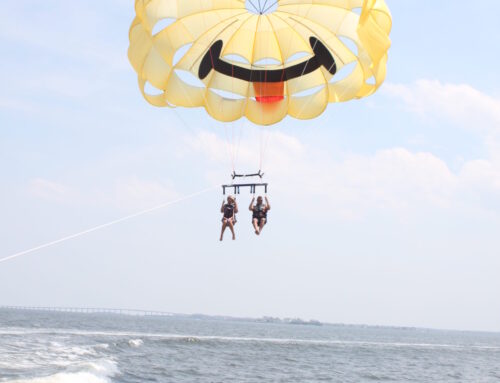This blog post takes us back to the early days of Kitty Hawk Kites, when a close friendship and a shared passion for adventure led to something much bigger. In this story, Buxton reflects on his journey with his friend and fellow co-founder, John Harris, as they discovered the thrill of hang gliding on Jockey’s Ridge. Together, they helped turn that passion into a business that would shape the Outer Banks’ outdoor industry and regional economy. Through Buxton’s eyes, we get a glimpse of the excitement, challenges, and fun that came with building Kitty Hawk Kites, making this story not just about flying, but about friendship and following your dreams.
The first time I saw Jockey’s Ridge was on a weekend visit in the fall of 1972. I had been doing a project on a Coast Guard cutter out of Portsmouth and had the weekend off to play. The nearby Outer Banks landmarks of Cape Hatteras and Wright Brothers Monument were drawing cards for me, and the Outer Banks was only a few hours away. I drove south on the old two-lane bypass 158 highway through Kitty Hawk and Kill Devil Hills, and past the Wright Brothers monument. I wanted to get to my motel so didn’t take time to stop at the monument, but I made a mental note where it was. Further down the road I entered the town of Nags Head, and as I came around a bend in the road, there on the right was this massive, majestic sand dune. It seemed like I had driven into the Sahara Desert. There was no way to drive by Jockey’s Ridge without the urge to climb it! The sight of this magnificent sand dune is a sight I’ll never forget. Opportunely, there was some shoulder parking and I pulled over to the side of the road, jumped out of the car, and headed for the top of the largest peak. It felt like being a kid in a big sand box all over again. Once I got to the top, I saw the sight of both the ocean and sound with a ribbon of land between, and the reality of the Outer Banks as a big sandbar hit me. What an amazing view! Back then, the topographical maps showed the elevation of the ridge at 132 ft. compared to the current approximate height of about 70-80ft. The slopes of the big dune were very steep and with the loose sand it was hard to climb. Coming back down the sand cliff, it was just natural to try to run, and leap in big hops while trying not to face plant. Little did I realize that in my future would include other types of controlled crashes on the dune.
Later, I came to understand why the Outer Banks was a sportsman’s paradise and a mecca for outdoor activities like fishing and surfing. The combination of miles of beautiful beach, ocean surf, shallow sounds, and steady winds lent themselves to all kinds of activities. This was a place that I wanted to explore more

The North East Dune of Jockey's Ridge in the 70s. Buxton describes the first time he saw the incredible landscape.
In the summer of 1973, John Harris called me all excited about a new sport called hang gliding. I was struck with his enthusiasm because if John was excited it had to be worth exploring. Hang gliding is a hard concept to describe over the phone to someone who has never seen one much less a photo. The vision that John described of using this wire, aluminum, and dacron contraption to fly off a mountain really strained my imagination, but I knew that if my good friend John was in, I was in! Flying had always interested me. My dream in high school had been a pilot but back then neither the Air Force nor Naval Academy would accept applicants who need glasses. During high school I worked at a small private airport as a gas boy and anything else that needed to be done like waxing the airport owner’s Piper Cherokee and mowing the grass runways. I wanted to take flying lessons, but I was also saving for my first car and like most teenage boys, that took priority. When John said that he had ordered a hang glider from a company in Utah my interest peaked. Finally, I was going to be able to learn to fly!
Backing up a few years, both John and I both studied engineering at a different college in the Midwest. Like John, I had heard about co-oping, a college program of alternate work and study semesters, as a good way to get work experience and to earn money. It seemed like a good way to take a break from the grinding engineering course loads. When I asked an advisor about the program, and he gave me information from Lockheed Missiles and Space Company in California. Working for a space company appealed to me, but “California” was the magic word. This was the mid 60s and the Beach Boys, California Dreaming hippies, and Route 66 were trending. I applied and got accepted to work at Lockheed in Sunnyvale, California, near present day Silicon Valley, south of San Francisco. I couldn’t wait to for the spring semester to end and to get on the road with my ’59 Ford Edsel packed with all by belongings. The Edsel almost didn’t make it. It broke down outside of Rawlings, Wyoming and was just able to limp back into the town. I thought I was going to have to leave the car and take a bus. Money was tight. But by good fortune I met a mechanic in a diner who offered to work on it. Miraculously, he found it was just a bad bushing in the transmission, fixed it, and I was on the way, but I had lost a day of travel time. When I got to the Lockheed employment office, to check in, I started talking with another fellow who had also come from the Midwest. It was John M. Harris. I could thank the Edsel breaking down for that fortuitus meeting. We ended up spending a lot of time together over the next few years exploring California, Hawaii and other parts of the West Coast when we weren’t working or going to school. We both shared dreams of someday figuring out a way to work for ourselves, at that time, most likely in engineering. This was the era that NASA was going to put a man on the moon in a few years. Anything seemed possible. Inner space, the depths of the ocean, was also getting a lot of attention as the next frontier. There were a lot of opportunities in engineering if you had the right idea and lots of money to fund it. Mining the bottom of the ocean bed was a popular idea and we thought we could get in on the next gold rush. The world was our oyster.
California was a land of opportunity, not only for work but also for having fun. The state had all the assets like beautiful beaches and mountains and open-minded free-spirited people. John and I, and another student from John’s school, Dale Hasselfeld ended up becoming roommates and good friends over the next two years. Skiing in the Sierras and camping trips to Yosemite were highlights. John and I spent a summer in Hawaii learning to surf at Waikiki while taking classes at University of Hawaii. I have lots of fond memories about those experiences. Naively, we mused that having your own business would give you more time to play. Ha!

Ralph Buxton (far right) met KHK CEO and co-founder, John Harris while working as an engineer in Sunnyvale, California. They would go on to form a close friendship and business partnership in the Outer Banks.
After college John ended up working at Western Electric in Winston-Salem, NC doing undersea research and surveying. He had a friend and co-worker, Otto Horton, who was from Chesapeake, Virginia and very familiar with the Outer Banks. When John told him about having ordered a hang glider, Otto suggested Jockey’s Ridge as a place to learn to fly it. Just like the Wright Brothers experience, the soft sands and steady winds, were mighty enticing for novices who had never flown anything beyond a paper airplane or string kite. John was enrolled that fall in graduate oceanography at Old Dominion, in Norfolk. When John called to invite me to hang glide, I was living in Annapolis, Maryland doing undersea vehicle design at Westinghouse. It didn’t take much convincing to get me to join the trip. To be able to both return to the Outer Banks and to learn to fly was like a wish come true! And to be able to continue the adventure and exploring that John and I had started in California was a nice weekend escape from the corporate life.
That first hang gliding experience at Jockey’s Ridge is a day that I’ll never forget. Most of us knew little about hang gliders, but John had gotten some basic instructions from the builder, so we went to it. A Super 8 mm film had also been sent along showing some basic flying instructions. John had watched the short film and reported it was simple to control. He was the expert, amongst us anyway. So, we took the glider up the smaller dune, a few hundred feet from the highway and decided to launch there because it was steep enough and the winds seemed right. John was the test pilot and dang if he didn’t pull it off nicely. Each of us then had our turn and we tried to emulate him. As many hang gliding instructors have experienced, once you launch somebody in a hang glider and their feet leave the ground, they’re hooked. We wanted to get higher and go further. The Wright Brothers would not have been impressed with our style. We got a bit ahead of ourselves, the glider was damaged, and we had to call it a day. But the seed had been planted that hang gliding had a lot of appeal as a sport. We talked a lot about that and how this could be a business. That fall/winter, along with Buddy Ramey who had a marketing and public relations background, a business and marketing plan was developed. The name Kitty Hawk Kites and a cool logo jumped out of that process, and we knew we had a winner. This was a time that the country was going through the Arab oil embargo and the resulting recession. Not the best time to start a business but we didn’t know any better and our enthusiasm overcame any doubts. As it happened, we found later that our timing to use Jockey’s Ridge was fortuitous.

Buxton, Harris, and their friend Otto Horton came to Jockey's Ridge with a mail-order hang glider and learned to fly in the course of an afternoon. Afterwards, Buxton and Harris became inspired to share the experience with others..
By the spring of 1974, Kitty Hawk Kites was incorporated, and enough stock was sold to be able to order some hang gliders and get us “launched”. Our initial business plan was based on the model of snow skiing, basically, that people would take an introductory lesson and then rent a glider and get more experience on their own like is done at ski resorts we had visited in California. We later discovered that was unrealistic because people would break the gliders or could get hurt, but it had looked good in the initial business plan. John started to look for a business location near Jockey’s Ridge. After being laughed out of the office by several local realtors when inquiring about rental space for the new kite flying business, John met Stan White who was starting in real estate while teaching at the local high school. Stan took a personal interest and was able to find an old garage behind the vintage Nags Head Casino dance hall and advise us over the years. The rent was an affordable, $75/month, and the location was ideally right across the street from Jockey’s Ridge. We even had a separate outhouse. Back then Jockey’s Ridge was all private property, divided into parcels but nobody knew where their property lines were because the sand kept moving and changing the landscape. So, it was pretty much open territory for anyone to use within reason. We were very lucky to find that location. Tom White was the local attorney who gave us good legal advice.
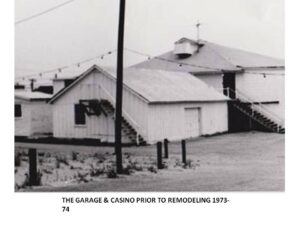
The garage: The original home of Kitty Hawk Kites.
Not too long after we got set up, we had a visit by Carolista Baum to enlist our help to preserve the dunes. She, with the help of several local folks had formed a non-profit organization called People to Preserve Jockey’s Ridge, and used the slogan Save Our Sand dune (SOS. Kitty Hawk Kites became part of a community movement to preserve the dunes and save it from development. The importance of protecting this beautiful unique landscape was obvious, not only for hang gliding, but for all the reasons people climbed it like beautiful sunsets over the sound, the glow of a full moon, flying a string kite, or rolling down the slopes. Everybody was inspired once they climbed the ridge and stood on top enjoying the view. A lot of our students and fellow hang gliders contributed by buying a token square foot of the dune and signing the petition drive. The local community really got behind the movement. Jockey’s Ridge had always been a playground for the community. Legend was that there were horse races in the sand bowls, pirates lured ships with lanterns hung from nags, and much later, locals gave tourists dune buggy rides. There was even a story about someone offering camel rides. With the Casino dance hall in its back yard, many a couples climbed the dune to watch the sun set and the moon rise. Everybody had a story to tell about Jockey’s Ridge, and yes some are tales that could fill romantic novels. The Outer Banks community and folks like Marlene Roberts, Charles Evans, Eddie Green, and George Crockers were instrumental in building the broad support that was needed to galvanize the State legislature. Carolista was very good at trumpeting the cause, but politicians like to ride the train, not get in front of it.
A major contribution by Kitty Hawk Kites to the preservation of Jockey’s Ridge was the advertising and promotion of people learning to fly near the birthplace of flight, and in fact, in that day, within few of the Kill Devil Hills’ Wright Brothers Monument. A picture is worth a thousand words and this one really struck a chord with the public. Hang gliding on Jockey’s Ridge was a colorful fresh new subject and it got a lot of free national exposure for the Outer Banks. The Chamber of Commerce and the Dare County Tourism Bureau loved it! And the State of North Carolina Travel and Tourism office loved it. At a time of national economic weakness and gas shortage, the value of Jockey’s Ridge and hang gliding as an attraction to the area was a big marketing gift.
In the spring of 1975, the North Carolina legislature passed legislation to establish Jockey’s Ridge State Park and begin acquiring land. We celebrated the preservation of Jockey’s Ridge, but we also came to learn that we had opposition to operate in a State Park. The enthusiastic woman that had sought our help to save Jockey’s Ridge was now lobbying to ban us. We were in uncharted waters, and we had to learn to swim with the sharks very quickly. They don’t teach politics and lobbying in engineering school. The Outer Banks business community came to our help, and fortuitously I was on the chamber of commerce board and president. They recognized us as a tourism attraction and promotional vehicle for the Outer Banks. Our local politicians also understood the value of hang gliding to the area. In addition, John had a friendship with Hugh Morton, owner of Grandfather Mountain who was well connected in state politics and willing to help. John had been the first person to fly Grandfather in 1974, a terrific promotional flying feat. Later we set up a hang gliding shop in Linville, NC, at the base of the mountain and supported the demonstration team at Grandfather. Mr. Morton was very savvy promoter of his mountain and a good friend of the sport and a good coach on how to work with government. It took a lot of letters and trips to Raleigh to solidify our support. It taught us the value of networking in our community. Although the State Parks Department favored preservation, recreation was starting to be more accepted as a beneficial use. If we had not been there before Jockey’s Ridge became a park, it would have been very difficult to get our foot in the door to make that case with a new sport like hang gliding.
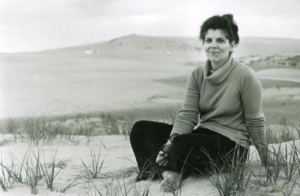
Carolista Baum is the face of Jockey's Ridge preserveration story. But, Kitty Hawk Kites also played a key role in helping the sand dunes gain State Park status.
The two most important people we met in the spring of 1974 were Francis and Gertrude Rogallo, inventors of the flexible wing used in hang gliders. Francis had retired from a career with NASA Langley where he had researched applications such as space craft recovery with the Rogallo wing. Luckily for us, he chose to live in on the Outer Banks. With his newfound freedom Francis had taken up hang gliding as a sport and often came to Jockey’s Ridge to fly hang gliders or their flexi-foil string kite. Francis and Gertrude were regular visitors at our shop, and we all quickly became friends. They were delightful people, full of life, and a joy to be around. Francis was a wonderful ambassador for hang gliding and for Jockey’s Ridge preservation, and often talked to curious bystanders as he patiently waited for those perfect winds to launch his glider. He was always available to talk to hang glider pilots and share his knowledge, and he spent a lot of time answering correspondence with designers and manufacturers. They were very active in promoting string kite flying on Jockey’s Ridge as a clean, family friendly public use of Jockey’s Ridge. They even created a SOS string kite for People to Preserve Jockey’s Ridge and went to Raleigh to promote it. As the celebrity inventor of the flexible wing and “father of hang gliding”, Francis was often interviewed by the press bringing attention to the SOS campaign. Rog, as his friends called him, was also a big fan of the Wright Brothers and he loved to point to the Wright Brothers monument just a few miles up the road where the Wright Brothers had learned to fly. When Jim Johns, our hang gliding manager, thermaled his glider out of Jockey’s Ridge and flew up to the Wright Brothers monument Rog put up a prize for the first person that could do that and return to Jockey’s Ridge, but unfortunately nobody has ever accomplished that feat. Rog was always thinking, and he envisioned a Wind Use facility at Jockey’s Ridge because it seemed like a natural aerodynamic laboratory to him. Without the vast publicity of Rogallo’s NASA space craft recovery research using flexible wings, hang gliding would not have developed as a sport nearly as quickly if at all. Paragliding, sport parachuting, kite surfing, and kite flying also greatly benefitted from the flexible wing research. I admired the Rogallos as genuinely good people who freely and enthusiastically shared their gift of the Rogallo wing.
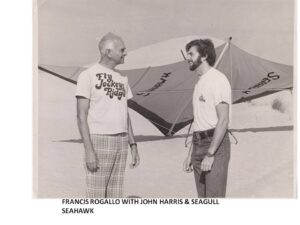
Former NASA scientist and flexible wing inventor, Francis Rogallo (and his wife, Gertrude) were instrumental in the early days of Kitty Hawk Kites and the growth of the sport of hang gliding.
The first few years of Kitty Hawk Kite business were a success in terms of showing the public wanted hang gliding lessons, but it barely made enough money to support John. We needed more capacity. The potential growth of the sport beyond the Outer Banks was apparent. John was running himself ragged instructing, repairing gliders, plus the other stuff it took to run a business. He never went back to graduate school after the first semester and within a few years it was becoming more obvious that he needed more help. I would say he got his MBA in business and public relations on the job. He did a terrific job in keeping it the business on even keel and keeping the wolves at bay, but he need help and more resources.
At that time, I was working in Washington DC for the US Coast Guard. I was coming down from Washington on weekends and vacations. The roads to the Outer Banks were not as improved as they are today, and the trip took 7or 8 hours. Going to the Outer Banks was full of anticipation in being on the dunes helping to teach. Driving back to DC after an exhausting weekend was not as much fun and sometimes, I had to pull off the road and crawl into the back to sleep or call in sick the next day. It was a small price for this adventure of being a budding entrepreneur. Some days we had to each teach 3 or 4 lessons because we had students booked and not enough instructors. On a hot summer day, with light, or no wind day it really exhausted you and was not sustainable. But I always liked to remind our later instructors like Tom Haddon and Glenn Hockett that was how we did it in “the good old days!” Of course, if the winds picked up and lessons had to be canceled, instructors still found the energy and desire to go flying. With an ocean nearby, surfing the sky was the greatest joy!

Buxton talks of successes and struggles in the early days of the business.
Some weekends, I did get to explore new flying sites in the hills and mountains of Virginia. I had met Vic Powell, who started the Capitol Hang Gliding Association, and he invited me to be an officer of the club. It was a great way to meet other pilots and learn about good flying sites. We also had to deal with landowners and in the case of the Blue Ridge Parkway and Skyline Drive, working through the bureaucracy of the government. Vic was an energetic advocate for the sport and as a former television reporter, and as a public relations aide for Virginia Representative Whitehurst he had great connections and was also able to get a lot of good publicity for the sport. Vic organized the first hang gliding event on the Outer Banks, the Tactile Flight Meet which later became the Hang Gliding Spectacular, currently the longest running hang gliding event in the world.
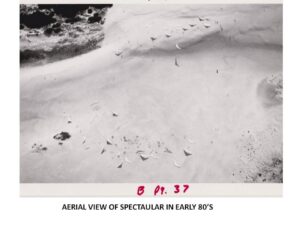
Buxton was fortunate to form a close relationship with Vic Powell, founder of the Tactile Flight Meet. After being taken over by Kitty Hawk Kites in the 70s, the KHK Hang Gliding Spectacular is the longest running hang gliding competition in the world--hitting 53 years this coming May.
Along the way, I decided I needed my own hang glider if I wanted to progress my skills and I purchased a Sun III glider from a company in Colorado. It was basically a Rogallo wing with some battens and a different sail cut, but it was beautiful in my eyes. I got to fly at High Top, Tater Mountain, Grandfather Mountain, and Ravens Roost. Mountain flying with a hang glider was moments of exhilaration interspersed with hours and days of finding suitable sites, getting permissions, and waiting for wind conditions to be good, and sometimes literally plunging into unknown territory. The early wings had glide ratios of 4-5:1 so you did not have a lot of leeway in flight planning. I had an encounter with a bulldozer on a test flight into a new small landing area at Grandfather Mountain that was real interesting. Back then then the sport was quickly evolving, and designs were constantly changing. There were dozens of manufacturers trying to carve out a piece of the market. You could even buy plans or kits and build them yourself. That might be good for someone with the skills, but not for your average do-it-yourselfer, who would have to also be a test pilot without any flying experience. The sport was getting a lot of bad press from accidents, and the injuries and unfortunate fatalities took their toll. To become proficient and safe, you really had to approach it with a great deal of respect. Mountain fling is not forgiving, and one pays the price for being careless or unprepared for changing conditions or dumb mistakes. Sadly, one of the most common tragic accidents was failure to hook yourself into the glider before you launched. The sport of hang gliding was having major growing pains and manufacturers began to fall out both because of both competition and liability. Fortunately, the best companies kept improving the designs and making them more forgiving as well as better performing. The industry also became more safety conscious with organizations like USHGA setting standards for pilots and schools. Very early, Kitty Hawk Kites set up a program of advancing folks to at least a hang 2 rating on the dunes, before we could consider taking them to the mountains, and we took that responsibility very seriously.
I had come to point where I had to decide where to direct my own time, energy, finances, and career. I had tried to set up an engineering consulting company, but it ran out of steam and that left me financially depleted. I had also spent 18 months in the Army in the early 70s. I enjoyed my job doing research for the Coast Guard mostly on icebreaking technology, and I got to spend time in the Arctic and the Great Lakes. A bonus project I got, because of my hang gliding experience, was to investigate a powered parachute concept. We looked at using it for a surveillance vehicle using with a tethered launch from a patrol boat and a big hook to catch the chute lines for recovery. Like a lot of research, nothing came of it. Research could be fun, but building Kitty Hawk Kites was a lot more exciting prospect. John had carried the weight of getting the business “off the ground”. We needed a plan to stabilize our access to Jockey’s Ridge and to grow and diversify the business. I was thrilled to trade Washington life for the Outer Banks. In January of 1977, I made the move to the Outer Banks.
At that time, Kitty Hawk Kites was still renting a small garage and, but our landlords were unsavory people who were struggling with the night club business. When the roof fell in on the original legendary Nag Head Casino night club building (origionally built in the early 1930’s as barracks for the Wright Brothers monument and later the CCC), the new owners had decided to build a build an addition to the nearby Quizo (bingo) parlor. In their “wisdom” they also decided to ditch the iconic name Nags Head Casino name, and switch from beach music to a disco music format. It didn’t go over well for them, and they put pressure on us to pay more rent. As a fall back in case the landlord didn’t extend our lease we secured a shop on the 1/2 mile north on the Beach Road, but we mostly used it for employee housing. We really needed something long term close to the Ridge. We experimented with a shallow draft jet-drive power boat to use for towing hang gliders and parasails over water. That was probably some of the most dangerous hang gliding that I’ve done. It felt like being launched by a giant rubber band. Certainly not a good idea for students.

Buxton shares stories of his personal hang gliding journey--including early towing flights.
Financially the business was showing promise but it was far from secure, with our short term shop lease and the uncertainty of the park situation. When not in the shop or on the dune, I focused on finding property to secure our proximity to the dune and get the financing. In 1978 we bought a small piece of land and built a new shop (where the Rogallo Tower currently is) that opened in 1979, It wasn’t big enough but it gave us the proximity to the dune and the foothold we needed. By then, we had enough of a track record and good relationships with bankers, Ray White and Chris Payne, to borrow the money. In that time , more so than today, bankers evaluated applicants on both the applicants’ character and the proposal’s business viability. For good reason they were skeptical of the business side, but at least we had the character part!
We had challenges with the business that we never dreamt of. State Parks’ long-term plan was to build a hang gliding concession building, but they were a long way from getting that accomplished. At one point, the Park closed the park access that was across the street from our shop blocking public access. We worked hard to have Kitty Hawk Kites be an asset to the community and we believed in giving back to the community. I was active on the Outer Banks Chamber of Commerce and president one year. In turn, people came to our help. Our local State Senators Melvin Daniels and later Marc Basnight helped us in dealing with government bureaucracy. When it was proposed to ban hang gliding on weekends, Governor Hunt overruled it. The State required us to have liability insurance for hang gliding. Amazingly, an insurance agency in Raleigh with an aviation enthusiast owner flew out to see us and offer his help. Insurance is a detail you don’t think about a lot when starting a new business but it’s scary if someone gets seriously hurt. We did take safety very seriously, but we had our share of broken wrists and bruises. When we first started the business, there wasn’t even a doctor on the Outer Banks, and you had to go to Manteo or Currituck. I remember having to drive friend Otto Horton, to a Norfolk with a badly broken arm. Fortunately for the community, as the Outer Banks grew it got better medical services and eventually and miraculously even a hospital. Unintentionally, we contributed to the need for better medical services.

Hang gliding was growing but we also wanted to figure out how to diversify in case we lost the ability to teach hang gliding on Jockey Ridge. We had a lot of eggs in one basket at Jockey’s Ridge. We also needed more parking. About 1980, we were approached about buying the old Casino property. We really needed that space, but it seemed like an overwhelming feat at a time when interest rates were above 20%. We looked at all kinds of options to subdivide or to find someone to buy it and lease it back. None of that worked. and then we had to figure out how to use it ourselves productively. We spent a lot of time at planning, brainstorming, and “strategizing”. Kitty Hawk Sports became an outgrowth of that planning, focused on water sports and the surf lifestyle, and that gave us another avenue of growth synchronized with the ocean and sound assets of the Outer Banks. Windsurfing, hobie cats, kayaking, body boards, skim boards, surf boards, stand up paddle boards and other sports became part of the business of marketing the Outer Banks outdoor lifestyle. The first year we put the business in the former Casino/Quizo building and filled the big space with watersports gear and an ultralight hang glider. Later we added a connection of shops between Kitty Hawk Kites and Kitty Hawk Spots and called it Kitty Hawk Connection (later changed to Jockey’s Ridge Crossing). The added space allowed us to triple the size of the Kitty Hawk Kites retail shop. String kites and toys became an ever-increasing important part of the business. And who would every have imagined the importance of t-shirts and other sport apparel and accessories. Later that strategy of diversification allowed the business to also establish retail shops away from Jockey’s Ridge throughout the Outer Banks and beyond. We even returned to California with a hang gliding school in Monterrey, California, probably our biggest overreach to manage a business three thousand miles away. Paul Miller, our CPA, joined the business to help us with finances as the business became more complicated. He also launched the Kitty Hawk Sports retail store and sailing school at the new Waterside in Norfolk in Norfolk, Virginia.

Some of Ralph's accomplishments with Kitty Hawk Kites include impressive expansion and growth, starting with the grand opening of their newest building in 1979.
Today, hang gliding continues to be the central theme to Kitty Hawk Kites and the theme of “Teaching the World to Fly”. With the flattening topography of the dunes, I am amazed how well it continues to do. Hang gliding instruction has also become a lot safer with the tether system and an instructor on each wing. That was a good idea! It may be time to resurrect the Save Our Sand dunes campaign before the Ridge disappears into the woods.
We were blessed to have wonderful people join the business. Many came here for the sports and others for the wonderful lifestyle of the Outer Banks. They walked the walk and talked the talk. John and Sandra Allen continue to lead the organization and from my perspective, their energy is amazing. All hail to the many passionate folks who have worked in the business, and thanks to the hang gliding instructors who have carried the flame up the hill – literally and figuratively. And a big hat off to the folks in the shops and in the back office who did their job so well to give both people who hang glide and those customers that want to enjoy another type of adventure that suits them the opportunity. Sandra Bull and Kelly Garner were key to the success of Kitty Hawk Sports, and I really depended on them to run that business.
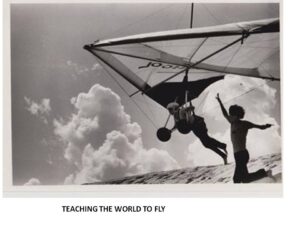
As for myself, I’m retired on the Outer Banks and am quite satisfied to be taking life a little easier but still able to be active. I wouldn’t have met my wife, Donna and have our family if I had not moved to the Outer Banks. I’m very lucky to have had her support.
If there’s a moral to this story it should be to never give up on your goals in life and take advantage of the opportunities that come along. Both John and I could have had good professional careers, but we would have missed the opportunity to live the Outer Banks dream and have a successful business. Luck and good timing helped but we also made our luck. As the saying goes: “Good luck is what happens when inspiration meets perspiration”. If you stumble, learn from it, and get up and keep trying. Ironically, isn’t that what we all did when we learned to hang glide?
Happy 50th Anniversary Kitty Hawk Kites!
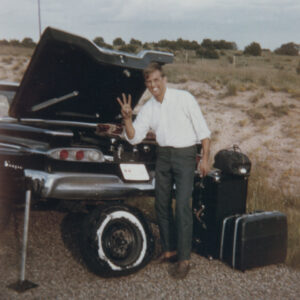
Ralph with that fateful Edsel.
About the Author
Ralph Buxton is a well-known local on the Outer Banks, celebrated for his role in shaping both the area’s business and community life. As a co-founder of Kitty Hawk Kites, he helped bring hang gliding to the Outer Banks, turning it into a must-do adventure for locals and visitors alike. Ralph has always been active in the community, working with groups like the Outer Banks Chamber of Commerce and supporting environmental causes. His commitment to the area earned him the title of Outer Banks Citizen of the Year in 2012, awarded by the chamber. Today in retirement, he remains a valued leader and advocate for the Outer Banks’ citizens and local economy.
Have a story to share? Nothing would make us happier than hearing from you. Visit kittyhawk.com/about-us/50th to learn more!

